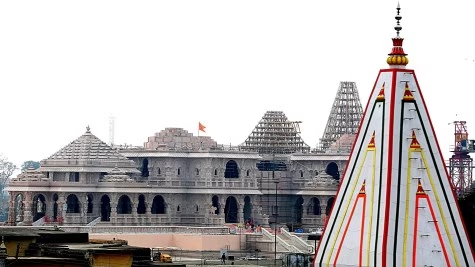"Ayodhya awakened collective consciousness of India," says UP chief minister Yogi Adityanath
"The consecration of Ram Lalla heralds the proclamation of the establishment of Ram Rajya in India," he writes.
"In a land where Ram Rajya was an ideal concept, Lord Ram had to prove his existence, and evidence was sought for his birthplace. But Shri Ram’s life teaches us to behave decently, and exercise self-restraint. The devotees of Ram demonstrated patience and perseverance, with their resolve growing stronger with each passing day.
Today, as Ayodhya regains its lost glory, the entire nation rejoices," he writes.
Yogi says that the 'Shri Ram Janmabhoomi Mukti Mahayagya' was not only a test of Sanatana belief, it brought to life the "collective consciousness of the nation" and united India in the "thread of unity".
He termed the fight for the Ram Mandir's construction at Lord Ram's birthplace "unparalleled", lauding saints, aesthetics, intellectuals, politicians and people from all strata of society for coming together and rising above differences for the occasion.
"The significance of January 22, 2024 goes beyond the consecration of the Bal-Roop Vigraha of Ram Lalla. It signifies the re-establishment of public faith and trust. Ayodhya is now being restored to its former glory. The joint victory of justice and truth is erasing bitter memories and creating new stories, fostering harmony in society," the UP Chief Minister noted.
"The convergence of diverse spiritual traditions — Shaiva, Vaishnav, Shakta, Ganapatya, Patya, Sikh, Buddhist, Jain, Dashnam Shankar, Ramananda, Ramanuj, Nimbarka, Madhava, Vishnu Nami, Ramsanehi, Ghisapanth, Garibdasi, Akali, Nirankari, Gaudiya, Kabirpanthi — representing myriad schools, sects, worship methods and traditions, alongside saints from over 150 traditions, as well as prominent figures from more than 50 communities,
.........including forest-hill dwellers, tribal groups and luminaries from various fields such as politics, science, industry, sports, arts, culture and literature, all converging under one umbrella is truly unprecedented."
(Yogi also says that PM Modi on Jan 22, 2024 will "eloquently convey the sentiments of 140 crore Indians in front of Shri Ram Lalla" )
Ayodhya means a city where there is no war, .....all bitterness should end" - RSS chief Mohan Bhagwat
“Now, the conflict that has arisen, as for and against the dispute, should be ended. The bitterness that has arisen in the meantime should also end. The enlightened people of society must see that the dispute ends completely. Ayodhya means a city where there is no war, a place free from conflict,” he has said in a write-up shared with The Indian Express.
“In the devotional celebration of January 22, along with the reconstruction of the temple, all of us have resolved for the reconstruction of Bharat and, through it, pave the way for reconstruction of the entire world," says RSS leader.
Blasting at the “politics of appeasement”, he says: “After Independence, when the Somnath temple was unanimously renovated, the discussion about such temples started. A similar consensus could have been considered regarding the liberation of Ram Janmabhoomi, but the direction of politics changed".
"The selfish forms of politics such as discrimination and appeasement became prevalent and hence the question remained as it is.”
“The occasion of construction of Shri Ram Temple in Ayodhya marks the reawakening of national pride. This also signifies the acceptance of the vision of life behind the character of Shri Ram by the modern Bharatiya society,” Bhagwat writes.
Recalling that Hindus and Muslims fought the British together in 1857, he says there was a chance for reconciliation through banning of cow slaughter and “liberation” of Ram Janmabhoomi. “Bahadur Shah Zafar also guaranteed a ban on cow slaughter. As a result, the entire society fought together. Bharatiya people showed bravery in that war but, unfortunately, this war of Independence failed… British rule remained uninterrupted, but the struggle for Ram Temple did not stop.”
“In 1949, the murty (idol) of Bhagwan Shri Ramchandra appeared at the Ram Janmabhoomi. In 1986, the temple was unlocked as per the court order. In the coming period, the struggle of Hindu society continued through many campaigns and karseva.
In 2010, there was a clear judgment of the Allahabad High Court. The efforts had to be sustained for final resolution of the issue at the earliest. On November 9, 2019, after 134 years of legal struggle, the Supreme Court gave a balanced decision after examining the truth and facts…
Now, Paush Shukla Dwadashi Yugabd 5125 (reference to Hindu calendar), on January 22, the installation and Pran Pratishtha ceremony has been organised,” he says.
ends












No comments:
Post a Comment